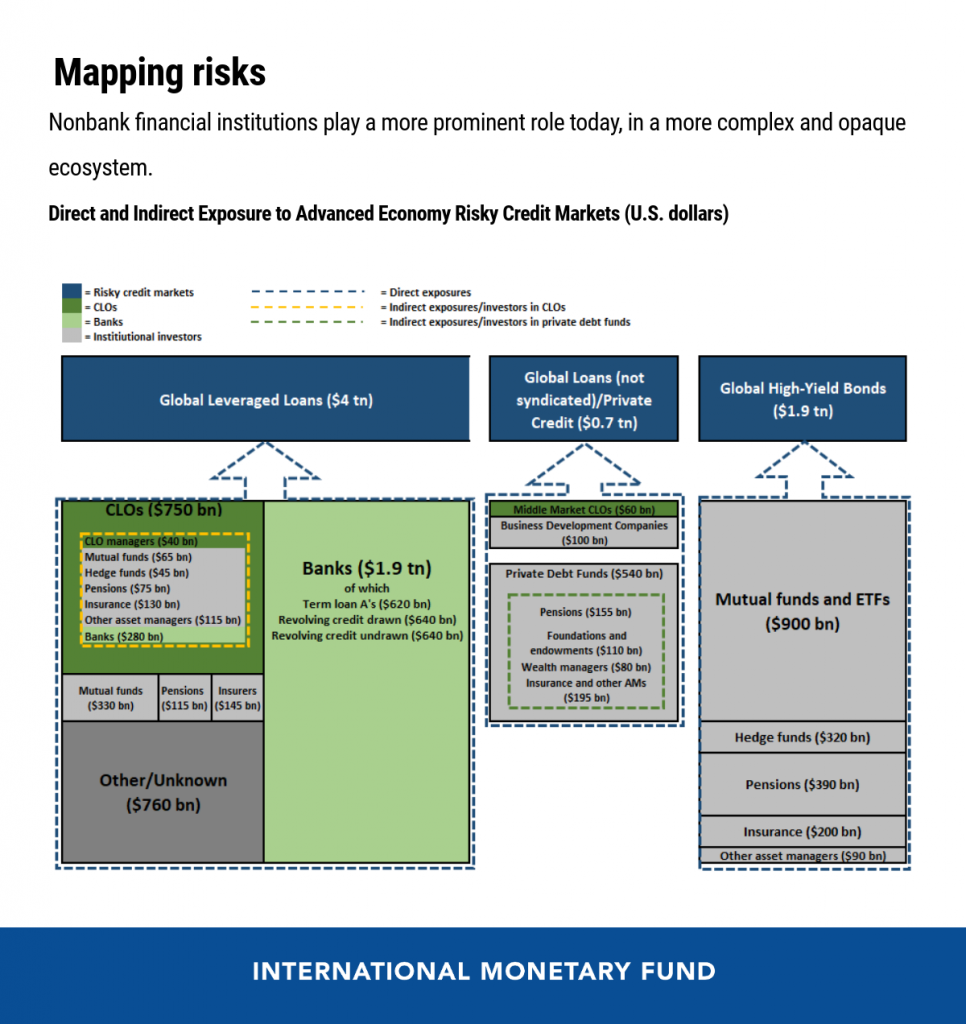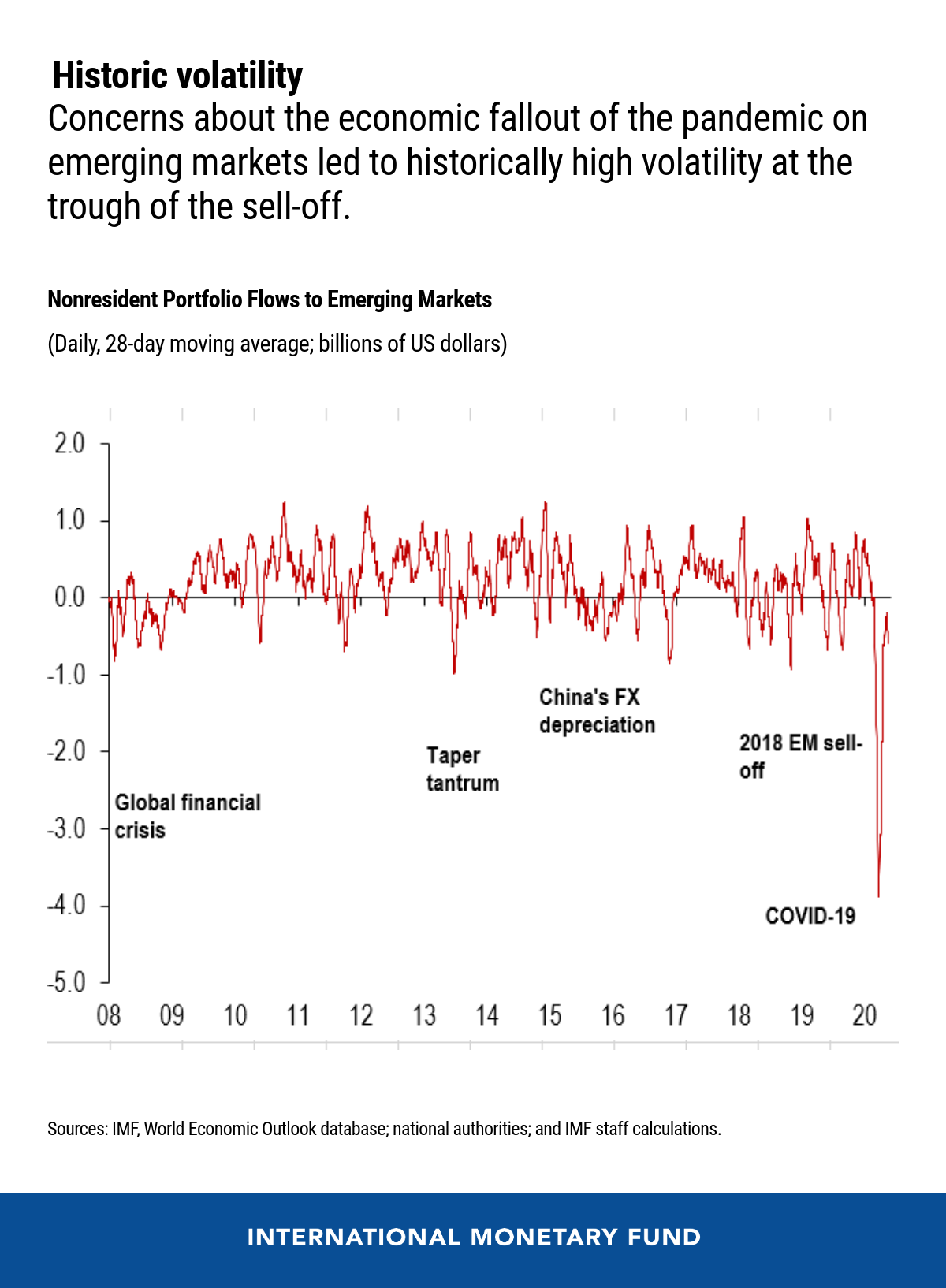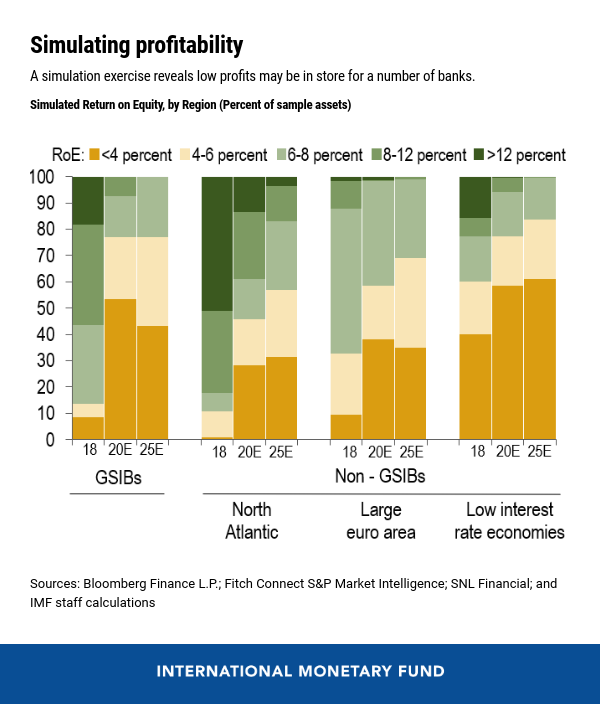عربي, 中文, Español, Français, 日本語, Português, Русский
Much the same way COVID-19 hits people with pre-existing health conditions more strongly, so is the pandemic-triggered economic crisis exposing and worsening financial vulnerabilities that have built up during a decade of extremely low rates and volatility.
Our recently released chapters 2-4 of the Global Financial Stability Report focus on three potential weak spots: risky segments in global credit markets, emerging markets, and banks. Should the ongoing economic contraction last longer or be deeper than currently expected, the resulting tightening of financial conditions may be amplified by these vulnerabilities, causing more instability or even a financial crisis.
Vulnerabilities in credit markets, emerging countries and banks could even cause a new financial crisis.
Risky corporate credit markets
Risky segments of credit markets have expanded rapidly since the global financial crisis. Potential fragilities include borrowers’ weaker credit quality, looser underwriting standards, liquidity risks at investment funds, and increased interconnectedness.
On the positive side, risky corporate credit markets our analysis finds that investors’ use of borrowed funds to finance their investments in these markets is less prevalent and that banks’ are not as heavily exposed to leveraged loans and high-yield bonds as in the past. Both factors contributed to the global financial crisis a decade ago. The risk of investor runs have also lessened in some segments because of a prevalence of long-term, locked-in capital in the private debt and collateralized loan obligation markets.
In a severely-adverse scenario, overall bank losses in risky corporate credit markets should be manageable, although they could be substantial at a few large banks. Losses at nonbank financial institutions, however, could be more significant. Given that nonbank lenders have taken a more prominent role in these markets, this could hurt credit provision and lead to a longer and more severe recession.

Policymakers should act decisively to contain COVID-19’s fallout and support the flow of credit to firms. In only a couple of months through late March, prices in risky credit markets dropped by about two-thirds of the declines experienced during the entire global financial crisis (a portion of the losses were since reversed). At the same time, interconnectedness across risky credit markets has likely contributed to market turbulence. A broad-based demand for cash has triggered selling pressures, and mutual funds have experienced large outflows (even though they have declined or reversed more recently). Regulators should encourage asset managers to be prudent and use all available liquidity management tools to address such risks.
Once the crisis is over, a comprehensive assessment of the sources of market dislocations and underlying vulnerabilities it unmasked should be conducted. For example, policymakers should consider whether including nonbanks in the regulatory and supervisory perimeter is warranted, given their expanded role in risky credit markets. In particular, a framework for macroprudential regulation of nonbank institutions, taking into consideration the global nature of these markets, should be developed and the macroprudential toolkit should be expanded.
Managing volatile portfolio flows
Since the beginning of the pandemic, emerging markets saw capital outflows of over $100 billion, nearly twice as big (relative to GDP) as those experienced during the Global Financial Crisis.
While outflows have since subsided, this dramatic swing underscores the challenges in managing volatile portfolio flows and the risks this may pose to financial stability.
The prolonged period of low interest rates encouraged both borrowers and creditors to take on more risk. The resulting surge of portfolio inflows into riskier asset markets contributed to the buildup of debt and in some cases resulted in stretched valuations in emerging and frontier markets. As a result, they have become more reliant on foreign portfolio flows since the global financial crisis.
Our analysis suggests that both bond and equity flows are much more sensitive to global financial conditions during periods of extreme flows than in normal times, while domestic fundamentals (such as economic growth, external vulnerabilities, domestic financial market depth) matter incrementally more for equities and local-currency-denominated bond flows. Furthermore, greater foreign investor participation in local currency bond markets that lack adequate depth can greatly increase the volatility of bond yields.
Emerging markets should manage external pressures by allowing their exchange rate to depreciate. If exchange-rate movements become disorderly, authorities should consider intervening in foreign exchange markets. Temporary capital flow management measures may also have to be used in the face of substantial outflows. Sovereign debt managers should prepare for longer-term funding disruptions by putting contingency plans in place to deal with limited access to external financing.
Banking: low rates, low profits?
Profitability has been a persistent challenge for banks in several advanced economies since the global financial crisis. While very accommodative monetary policy was crucial to sustain economic growth during this period, providing support to bank profits, extremely low interest rates have also compressed banks’ net interest margins—the difference between interest earned on assets and interest paid on liabilities. Our analysis shows that, beyond the immediate challenges associated with the COVID-19 outbreak, a persistent period of low interest rates is likely to put further pressure on bank profitability in the coming years.
Healthy banks play a key role in any dynamic economy, and are crucial for financial stability. When unable to generate profits, banks are less likely to provide loans and other financial services to households and firms, starving the economy of much needed credit. A simulation exercise conducted for a group of nine advanced economies indicates that a large fraction of their banks, by assets, may fail to generate profits above their cost of equity in 2025.
The COVID-19 outbreak is an additional test to banks’ resilience. Once immediate crisis-related challenges recede, banks could resort to fee income increases or costs cutting to mitigate pressures on profits, but it may be challenging to fully allay such pressures. Meanwhile, taking excessive risks to recoup profits may sow the seeds of future problems. It is therefore crucial that policymakers rapidly find a balance that safeguards financial stability and financial institutions’ soundness, while supporting economic activity. Various strategies to preserve and strengthen capital should be considered, including restricting dividend payouts and share buybacks.
In the coming years, authorities will need to take on some of the “structural” challenges banks face. For example, financial sector authorities should incorporate the potential impact of low interest rates in their decisions and risk assessments. Supervisory capital planning and stress testing should include “lower-for-longer” scenarios, and the strength of business models in such an environment should be evaluated. Supervisors should also remain vigilant and prevent any buildup of excessive risks that could reduce the banking sector’s resilience.






